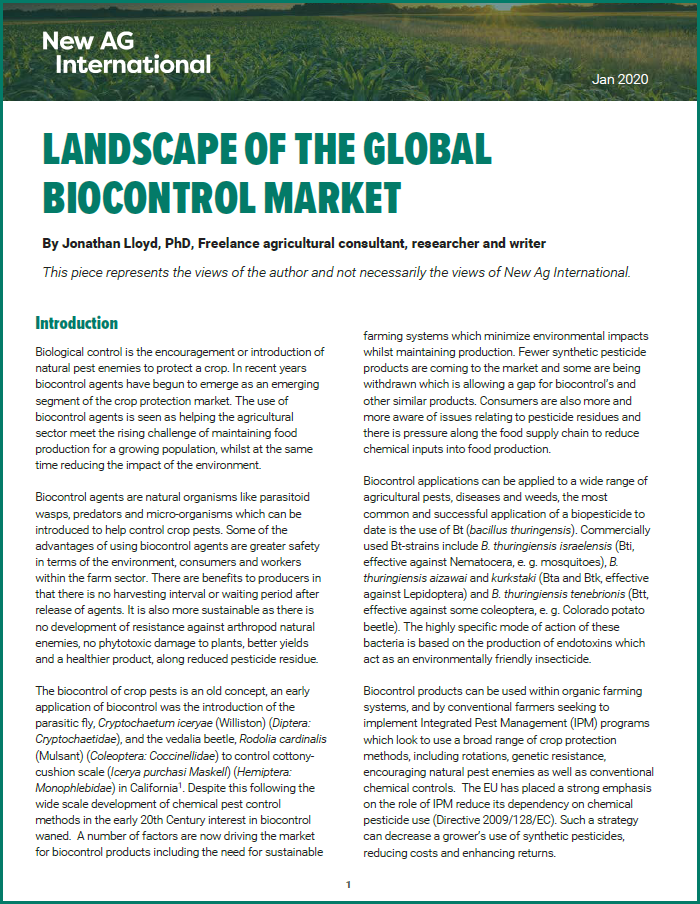

The microbial biopesticides market constitutes about 92 of total biopesticides and there is sufficient scope for further development in agriculture. Most important feature is that, they truly cut-down the application of chemical products, many of which are poisonous to humans and the environment. Bio-control products presently hold less than 2 of the global Fungi as Biocontrol Agents in Sustainable Agriculture 189 market of pesticide. Monitor the successes and failures of biological control releases in NevadaThe use of biological control agents is becoming more and more common throughout the United States.
CGIAR scientists have had successes over decades using biocontrol to tackle serious invasions and infections – for example, to control cassava mealybug and aflatoxins in Africa.In the 1970s, cassava mealybug invaded Africa and spread over the entire cassava belt, leading to widespread famine and affecting 200 million people, mainly poor farmers who rel ied on cassava as a staple. Biocontrol – or the method of using biological organisms to control pests and diseases – is one way to address the problem without resorting to potentially harmful chemicals. Pests and diseases can be devastating for crops, causing further problems for food security, health, nutrition, and livelihoods.
Economic studies covering 27 countries revealed a total gain of $8 billion to $20 billion and benefit-cost ratios of 200 to 740. The introduced wasp was shown to have an outstanding host-searching and dispersal capacity. Surveys in a dozen countries confirmed the ten-fold reduction of cassava mealybug population densities and damage in 95% of all fields. Lopezi was quantified over seven years in Nigeria, demonstrating long-term control.
These are registered for commercial use and the technology is transferred to the private sector for scale-up.To date, 14 products have been registered in 10 countries ( including Nigeria, Kenya, Senegal, The Gambia, Burkina Faso, Ghana, Zambia, Tanzania, Malawi, and Mozambique) with more under development in another 10 countries.Smallholder farmers have used Aflasafe products on more than 360,000 hectares of land to produce aflatoxin standard-compliant maize and groundnut. Four native atoxigenic strains form the active ingredients of each country-specific biocontrol product , generically named Aflasafe. No other technology provides such robust, safe, and consistent protection from aflatoxins from field to plate.CGIAR researchers at IITA , the CGIAR Research Programs on Maize (MAIZE) and Agriculture for Nutrition and Health (A4NH) and partners adapted and improved the atoxigenic strain-based biocontrol technology for use in sub-Saharan Africa. Some Aspergillus flavus strains do not produce aflatoxins – what are called atoxigenic strains – and can be applied in the field as biocontrol agents to displace aflatoxin producers, lowering contamination in crops up to 100%. The contamination was caused by certain Aspergillus species.
Photo by Aflasafe/IITA.The CGIAR Research Program on Maize (MAIZE), the CGIAR Research Program on Agriculture for Nutrition and Health (A4NH), the Bill & Melinda Gates Foundation, the United States Agency for International Development (USAID), the United States Department of Agriculture - Foreign Agricultural Service (USDA-FAS), the Alliance for a Green Revolution in Africa (AGRA), the Australian Government Department of Foreign Affairs and Trade (DFAT), United Kingdom Foreign, Commonwealth & Development Office (FCDO), Global Affairs Canada, the World Bank, the Meridian Institute, the European Union - H2020 and FP7, the African Agriculture Technology Foundation, USAID's Africa RISING, the German Federal Ministry for Economic Cooperation and Development (BMZ/GIZ), the Austrian Development Cooperation, the Norwegian Embassy in Mali, the French Development Agency (AFD), the International Fund for Agricultural Development (IFAD), the International Development Research Centre (IDRC), the Food and Agriculture Organization of the United Nations (FAO), and government donor agencies of Austria, Denmark, Germany, Italy, Norway, Switzerland, and the Netherlands.


 0 kommentar(er)
0 kommentar(er)
